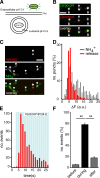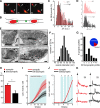Munc13 controls the location and efficiency of dense-core vesicle release in neurons
- PMID: 23229896
- PMCID: PMC3518216
- DOI: 10.1083/jcb.201208024
Munc13 controls the location and efficiency of dense-core vesicle release in neurons
Abstract
Neuronal dense-core vesicles (DCVs) contain diverse cargo crucial for brain development and function, but the mechanisms that control their release are largely unknown. We quantified activity-dependent DCV release in hippocampal neurons at single vesicle resolution. DCVs fused preferentially at synaptic terminals. DCVs also fused at extrasynaptic sites but only after prolonged stimulation. In munc13-1/2-null mutant neurons, synaptic DCV release was reduced but not abolished, and synaptic preference was lost. The remaining fusion required prolonged stimulation, similar to extrasynaptic fusion in wild-type neurons. Conversely, Munc13-1 overexpression (M13OE) promoted extrasynaptic DCV release, also without prolonged stimulation. Thus, Munc13-1/2 facilitate DCV fusion but, unlike for synaptic vesicles, are not essential for DCV release, and M13OE is sufficient to produce efficient DCV release extrasynaptically.
Figures




References
Publication types
MeSH terms
Substances
Grants and funding
LinkOut - more resources
Full Text Sources
Other Literature Sources
Molecular Biology Databases

